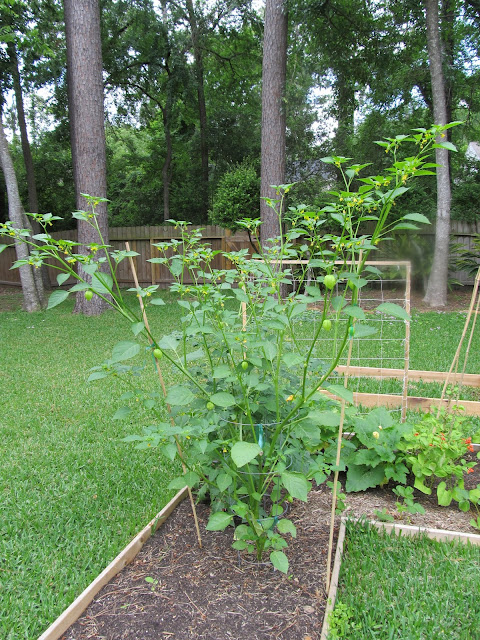My plan for this spring/summer was to plant the "three sisters" model - remember learning about that in elementary school, where the Native Americans used to plant corn, beans, and squash together? I thought it would be a fun experiment. . .until my experiment was hijacked by whoever runs and makes decisions for the community garden (more on that later).
Here's a picture of the plot shortly after transplanting 6 corn seedlings on March 14th (there's a little bunch of spinach there in the middle that has since been pulled up):
And what it looks like today (with the transplanted corn in the foreground - with the beginnings of tassels! - and the ground started ones behind them. You can also see the beans coming up around the base of the corn, but the cucumber plants in the back by the trellis are so small you can't really see them):
Once the corn was about a foot high, I planted 3 'Kentucky Wonder' beans 6 inches from the base of each corn stalk, so that as the corn grows, the beans will have a support to grow on and they will supply the nitrogen-heavy consumer that corn is with a little extra.
The next step was to plant the vining squash on the ground to serve as a "living mulch" to shade the soil and keep it free from weeds (and of course produce squash!), but there will be no more squash. And I hope that I will actually get my harvest of corn and beans. It was announced that the community garden will be doing a "solarization project", where starting June 28th, we have to remove every plant from our garden and every plot will be covered with black plastic until September. This is to supposedly correct a severe pest problem that could have been avoided in the first place by rotating crops and disinfecting tools. Let's just say I have rotated my crops properly, and hmmm, I don't (knock on wood) have a pest problem. I am so mad about this. And when I asked one of the head people of the community garden what happened if I was just about to get my harvest but it would be ready a little after the termination date of June 28th, and it was pretty much a "that would suck, because you'll have to take it out anyways". So after all my hard work all season, nothing.
I already know the cucumber plants I planted by the trellis I built will not be ready in time. AAARRRGGGHHH!!!
Ahem.
Anyways, that's the story.
So we'll see if at least my good ol' corn will give me some ears before the garden gets nuked!



















